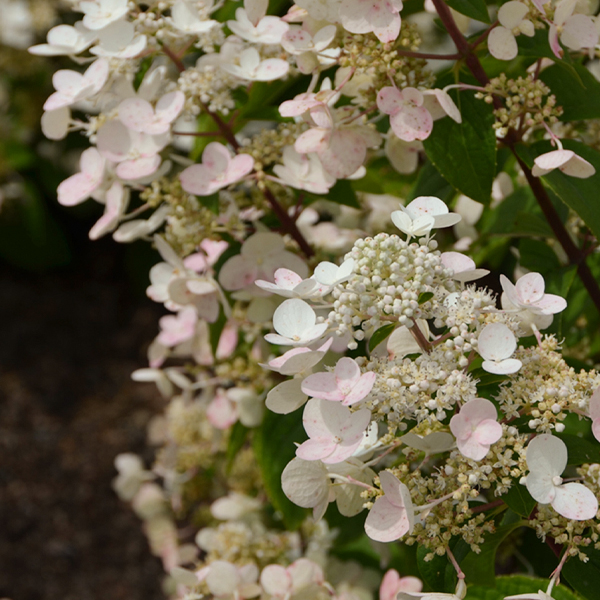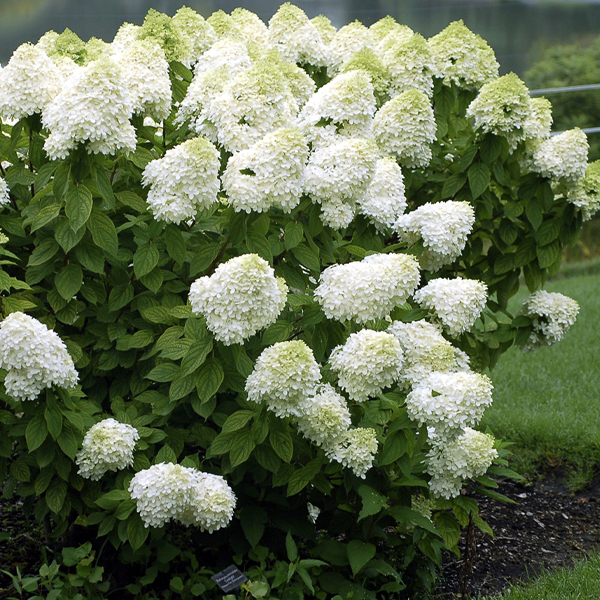

Comparative Trials of Hydrangea paniculata Cultivars
Comparative Trials of Hydrangea paniculata Cultivars | Issue 47 2022
Richard G. Hawke, Director of Ornamental Plant Research

VANILLA STRAWBERRY®
Panicle hydrangea (Hydrangea paniculata) has long been grown in gardens worldwide, as much for its prodigious floral show and robust habit as for its hardiness and adaptability in a broad array of landscapes. For many years, panicle hydrangea was represented in cultivation by only a few selections, most notably ‘Grandiflora’, ‘Floribunda’, and ‘Tardiva’. In fact, ‘Grandiflora’, introduced from Japan in 1862, is over-planted and has naturalized in portions of the eastern United States and Canada. Widespread and continued use of panicle hydrangea is a testament to the popularity and reliability of longstanding and contemporary cultivars alike.
Beginning in the 1970s, notable midsized cultivars such as ‘Brussels Lace’, ‘Greenspire’, ‘Unique’, and ‘White Moth’ among others were introduced in Belgium by Jelena and Robert de Belder, and many eventually ended up in American gardens. More recent plant development has increased the number of cultivars in the marketplace considerably, with much of the breeding and selection focused on enhanced flower colors and/or compact habits. Contemporary cultivars such as GREAT STAR™, LITTLE LIME®, and VANILLA STRAWBERRY® are popular because of their distinctive floral traits irrespective of plant size. Many of the newer introductions—coming from national and international breeders— are marketed in the United States through brands such as FIRST EDITIONS® (Bailey Nurseries), MAGICAL® (Plants Nouveau), and ColorChoice® (Proven Winners and Spring Meadow Nursery).
Hydrangea paniculata, native to eastern and southern China, Siberia, and Japan, is one of approximately 50 Hydrangea species worldwide, including other important garden shrubs and vines such as H. anomala ssp. petiolaris (climbing hydrangea), H. arborescens (smooth hydrangea), H. macrophylla (bigleaf hydrangea), and H. quercifolia (oakleaf hydrangea). The origin of the genus name—hydor meaning “water” and aggeion meaning “vessel”—refers to the cup-like fruit capsules. The specific epithet describes the arrangement of the flowers in a panicle, which is a many-branched inflorescence with multiple flowers clustered on each branch. The hydrangea family (Hydrangeaceae) consists of more than 200 species of trees, shrubs, vines, and herbaceous plants globally.
The signature ornamental attribute of panicle hydrangea is the robust inflorescences, which bloom on stout branches during the dog days of summer when many shrubs have finished flowering. Inflorescences range from 6 to 12 inches long but can be bigger; in fact, cultivars have been selected for larger, fuller flower heads. The panicles, comprised of both sterile and fertile florets, are often distinctly pyramidal or conical but are sometimes blunt-topped or rounded in outline. The yellowish white fertile florets are small, fragrant, and not intrinsically showy; nevertheless, butterflies and bees are common and bountiful pollinators. The showier sterile florets, varying in size from less than an inch to several inches wide, provide a dramatic, long-lasting floral show. The white to creamy white sterile florets are comprised of four or occasionally five ovate to elliptic petal-like sepals per floret. Regardless of shape or size, inflorescences may be designated as lace-cap or mop-head, although these terms are more commonly applied to the domed corymbs of bigleaf hydrangea. Lace-cap inflorescences feature numerous fertile florets and far fewer sterile florets arranged on the outside of the panicle. Mop-heads on the other hand contain an overabundance of densely clustered sterile florets with any fertile ones hidden within.
Sterile florets usually turn shades of pink in midsummer, remaining colorful into the late season. Recently, cultivars have been introduced that initiate color transformation earlier in the summer and/or that intensify the pink, magenta, and red of maturing blossoms. When summer color fades, the russet-tan sepals and fruit capsules provide some color and structural interest in autumn and winter landscapes. Flowers are produced on new or current season’s wood, so late winter pruning to reduce plant size or to shape the habit does not decrease flower production. Many gardeners report that annual pruning increases the size of inflorescences.
The deciduous dark green leaves are typically 3 to 6 inches long and half as wide and arranged oppositely on stout branches. The simple leaves are elliptic to ovate in outline with serrate margins. Fall color is yellow-orange to yellowish green and not typically ornamentally significant. Stem color varies from reddish brown to red among the cultivars; some selections feature more intensely colored stems that contrast beautifully with the white summer flowers and enhance the aging pink florets. Older bark is gray and often peeling. Hydrangea paniculata ranges from 10 to 20 feet tall at maturity, although most cultivars tend to be shorter. Pruning stems to half their height annually in late winter to early spring before leaves emerge further reduces plant size.
Hydrangea paniculata is hardy in USDA Zones 3 to 8 and is considered the cold-hardiest species. Moist, well-drained soils in full sun to light shade ensures strong growth and good flower production. Plants are shallow-rooted so consistent moisture is essential, particularly in warmer and drier climates. Panicle hydrangeas are tolerant of most urban conditions including salt spray, but foliar chlorosis may be an issue in alkaline soils. Bacterial wilt, leaf spot, powdery mildew, rust, aphids, mites, and nematodes are potential problems. Maintenance requirements are minimal. Annual pruning is often recommended but not necessary except to reduce plant size or to shape the habit. Accounts vary on whether annual pruning improves stem strength or enhances inflorescence size.
Panicle hydrangea’s workaday character gives way to something extraordinary at the onset of its impressive flowers. From midsummer onward, panicle hydrangeas put on a distinctive and dynamic flower show—the progression from creamy white to rich pinks and reds is delightful regardless of the size or fullness of the flower heads. Panicle hydrangeas are reliable hardy shrubs for woody and mixed borders, massed plantings, and hedging. While well-suited to a variety of landscapes, many cultivars are too large for small gardens; ‘Dharuma’, LITTLE QUICK FIRE®, and BOBO® are few of the compact selections for when space is limited.
List of Sections
The Evaluation Study
The Performance Report
Top-rated Panicle Hydrangeas
General Observations
Summary and Performance Chart
References
Dirr, M.A. 1998. Manual of Woody Landscape Plants, Fifth Edition. Champaign, IL: Stipes Publishing L.L.C.
Dirr, M.A. 2004. Hydrangea for American Gardens. Portland, OR: Timber Press, Inc.
C. J. van Gelderen and D. M. van Gelderen. 2004. Encyclopedia of Hydrangeas. Portland, OR: Timber Press, Inc.
Royal Horticultural Society, England. rhs.org.uk.
The Plant Evaluation Program is supported by the Woman’s Board of the Chicago Horticultural Society.



















